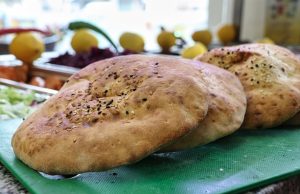
If you’re a fan of Middle Eastern cuisine, then you’ve probably tried both Saj and Pita bread. While they may look similar at first glance, they are two distinct types of bread with different origins, cooking methods, and flavors. In this article, we’ll explore the differences between Saj bread and Pita bread and help you understand which one to choose for your next meal.
What is Saj Bread?
Saj bread is a type of unleavened flatbread that is commonly eaten in the Levant and throughout the Middle East. It is also known by other names such as markook, khubz ruqaq, shrak, khubz rqeeq, and mashrooh. The bread is made from whole wheat flour and baked on a domed or convex metal griddle called a saj. The saj is heated over an open flame, and the bread is cooked on its surface until it puffs up and becomes slightly crispy.
What is Pita Bread?
Pita bread, on the other hand, is a round, leavened bread that is eaten in many parts of the world, including the Middle East. It is made from a combination of flour, water, yeast, and salt, and is cooked at high temperatures in an oven. Pita bread is known for its characteristic pocket, which is created when the bread expands during cooking, and then deflates as it cools.
Differences in Flavor and Texture
Saj bread and Pita bread have different flavors and textures. Saj bread has a slightly nutty flavor and is thinner than Pita bread. It has a delicate, crispy texture on the outside, and a chewy texture on the inside. Pita bread, on the other hand, has a soft, pillowy texture on the inside, with a slightly crispy exterior. The pocket of the Pita bread makes it ideal for stuffing with fillings such as meats, vegetables, and dips.
Nutritional Content
When it comes to nutritional content, Saj bread is a healthier option than Pita bread. Saj bread is made from whole wheat flour, which contains both fiber and vitamin D3 in abundance. A half loaf of Saj bread contains 33 grams of total carbs, 32 grams of net carbs, 1 gram of fat, 4 grams of protein, and 150 calories. Pita bread, on the other hand, is made from white flour, which is lower in fiber and nutrients. A half loaf of Pita bread contains 34 grams of total carbs, 32 grams of net carbs, 1 gram of fat, 5 grams of protein, and 170 calories.
Cooking Methods
Saj bread is cooked on a metal griddle, while Pita bread is baked in an oven. This difference in cooking methods gives the breads their distinctive textures and flavors. Saj bread is cooked at a high temperature on the saj, which creates a crispy exterior and a chewy interior. Pita bread, on the other hand, is baked at high temperatures in an oven, which creates a soft, fluffy texture on the inside and a slightly crispy exterior.
Read: Baladi Bread vs Pita: Understanding the Key Differences
Conclusion
Saj bread and pita are both popular Middle Eastern flatbreads, but they differ in several ways. Saj bread is made from whole wheat flour, which is rich in fiber and vitamin D3. This makes it an excellent choice for those who are on a low-carbohydrate, high-protein diet. On the other hand, pita bread is made from refined wheat flour, which is not as nutritious as whole wheat flour.
In terms of appearance, Saj bread is thinner and larger than pita bread. Each Saj bread is about the size of a round pillowcase and is so thin that you can almost see right through it. It is baked on a domed or convex metal griddle, known as a saj, which gives it its distinctive shape. Pita bread, on the other hand, is thicker and smaller in size.
In conclusion, Saj bread and pita bread differ in their ingredients, nutritional value, and appearance. While Saj bread is a healthier choice, pita bread is thicker and smaller, making it more suitable for filling with ingredients like falafel or shawarma. If you are looking for a healthier and larger option, then Saj bread is the way to go. However, if you want a more traditional and convenient option, then pita bread might be the better choice for you.











